ONE OF THE MOST BEAUTIFUL VILLAGES OF FRANCE

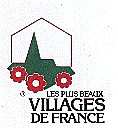 |
Saint-benoît du Sault was included in 1988 among the hundred "Most Beautiful Villages of France". Small medieval town situated three hundred kilometers south of Paris, founded in the Xth Century, it has developed around a benedictine priory. It is an active little town, known for its artistic and industrial activities. |
|
| History
of the town Visit of the medieval town L'église, le prieuré et le vieux barrage du lac Le quartier du Fort Dans la deuxième enceinte |
Contemporary
architecture The surrounding area Economy and development A place of artistic creation Calendar of manifestations The Town Hall publishes |
Welcoming
visitors Settling in Saint-Benoît du Sault Contacts. How to reach Saint-Benoît du Sault. |
Tous
les textes ont été écrits par Jean Chatelut & Michel
Gau
Les illustrations (hors photographies) sont des gravures d'André Vaugelade.
Twenty centuries later, in 974, some benedictine monks of the aera took refuge in Salis where they found a priory. From the Xth to the XVIIth century, the history of the priory and the new town of Saint-Benoît du Sault is made up of resistance to the possessive desires of feudal neighbours.
 |
From
the XVIIth century, the activity of artisans, paviour workers, of some prominent
persons or scholors were referred to in texts which were to become reassembled.
During the Revolution, a tree of liberty was planted, young volunteers left to defend the Republic and the town took on the name of Mont-du-Sault. |
| Like
all the communes of France, Saint-Benoît du Sault paid a heavy price in the
war of 1914-18. During the second conflict, it was the center of a region rich
in underground activities where arms of English origin were parachuted and
distributed as far as Paris at its Liberation.
In 1963 the factory SITRAM was created and Saint-Benoît du Sault rediscovered its desire to modernise and to develop, at the same time preserving its original charm. |
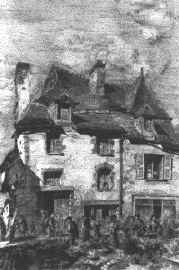 |
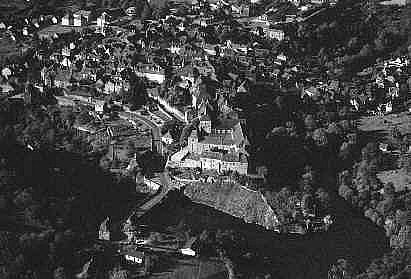
The town was surrounded by a double line of ramparts. The first, the most ancient, protected the priory, the church and the fort, the second established in the XVth century, encircled the commercial part.
 |
1 Maison des Voyageurs. |
 |
Church
Saint-Jean-Baptiste (12e s. ; 13e s. ; 15e s. ; 19e s.).
One of the most ancient monuments of the beginning of Roman Art. It dates from the year 1020. Its plan is still that of Roman basilicas. Its receptacle for baptism and its capitals are primitive and archeologists consider it one of the sites of the elaboration of Roman Art. Recently restored, its stained glass windows are a contemporary creation of Jean Mauret. The doorway at the west and the church tower date from the end of the XIIIth century. |
|
The priory. At the extremity of a promontory of granite, it dominates the valley of the Portefeuille (river). Founded towards 974, today it consists of XVth and XVIIIth buildings. |
 |
|
|
The barrage of the lake, seen from the terrace of the church, in its present condition, dates from the XVIIIth century when it was considered to be "one of the most beautiful of the kingdom." |
The Belfroy and the Fortified Gate form an exeptional unity. The gate with double port-cullis opens towards the XVth century town.
 The Fortified Gate of the XVth Century
|
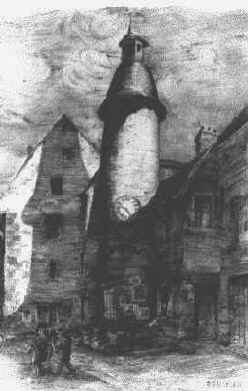 The Belfroy |
|
Dans
la deuxième enceinte, la plupart des maisons datent des XVè
et XVIè siécles, certaines ont été rénovées
au XIIIè siécle. Elles se distinguent par les linteaux
et les encadrements de leurs ouvertures : accolade, plein-cintre,
anse de panier...
La Maison de l'Argentier, au linteau sculpté classé Monument Historique, était celle où l'on battait monnaie. Dans cette partie de la ville, de nombreux commerces ont conservé ou restauré leur devanture en bois peint. |
 La Place de la République. |
 |
 Dans les vieilles rues... |
 |
La
rue du Portugal est l'ancienne voie vers le sud.
Ses maisons portent les traces des anciens étals moyenâgeux. Le pont Grimard et le pont Filloux, sur le Portefeuille, datent certainement du XVè siècle.
La meilleure visite est celle qui vous fait aller au hasard des ruelles, placettes, escaliers, dans une petite ville qui a su conserver un charme naturel |
Les créations contemporaines
Le patrimoine ancien de Saint Benoît du Sault s'est enrichi de créations contemporaines conçues par des architectes et des paysagistes de grand renom.
| Paul
Chemetov, Grand Prix national d'Architecture, auteur du Ministère des Finances et de la rénovation du Muséum d'Histoire Naturelle, a construit à Saint-Benoit le collège, les logements de la Grande Ouche, la gendarmerie, le Centre de Secours, le Bureau de Tourisme. |
 Gendarmerie - Paul Chemetov |
 Gymnase et Centre culturel.- Natchev |
Jacques Ripeault a construit la Salle Brassens, Et Dravzko Natchev, le gymnase. |
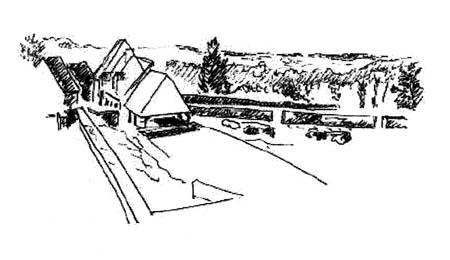
|
Les
jardins de la Grande Ouche ont été dessinés par
Gilles Clément auteur du Parc Citroën à Paris,
 Centre de Secours.- Chemetov |
 Collège Hervé Faye - Paul Chemetov |
In
the immediate proximity :
|
 In Roussines's chuch Photo : Michel Gau |
 The Anglin (river) near Saint-Benoît du Sault Photo : René-Jacques |
 Dolmen of Passebonneau In less than half an hour :
|
Une économie en développement
Au centre de la France, dans cet environnement favorable, des entreprises performantes ont créé un noyau d'activité industrielle :
-
la Sitram, premier fabriquant d'ustensiles ménagers en Europe,
- Decolmeta, mécanique de précision et décolletage,
- Sorecso,
-
Graphistyl, Impression sérigraphique
-
auxquelles s'ajoutent des entreprises artisanales du bâtiment et de nombreux commerces.
Plusieurs
hectares de terrains peuvent accueillir de nouvelles activités qui
bénéficieraient de conditions favorables :
- une taxe professionnelle très modérée
- un large bassin de main-d'oeuvre
- des logements disponibles
- un cadre de vie agréable
- des relations faciles :
et surtout Limoges, son Université et tous les services qu'offre une métropole de 350000 habitants sont à 40 minutes.
Un lieu de création artistique
Les artistes ont toujours aimé travailler à Saint-Benoit-du-Sault [surtout jusqu'en 2000].
Récemment :
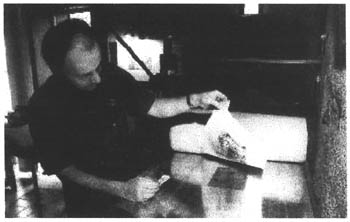 |
Le
graveur Georges Barral dans son atelier (W. Ronis Portrait de Saint-Benoît du Sault) |
certains s'y sont installés
|
Josum
Walstra dans son atelier,
|
 |
Situated at the crossroads of many departments and regions, Saint-Benoît du Sault has chosen to be a place of exchange of products, and know-how. Throughout the year, its manifestations bring together a very varied public, from far afield at times :
|
||||||
As
well as these regular manifestations can be added a big exhibition of Photography
from the middle of July to the end of August.
Others exhibitions, concerts, theatre and courses, of which there is an annual
programming, can be obtained from the town hall of Saint-Benoît du Sault (contacts).
Small hotels and guest rooms (chambres d’hôtes) can receive visitors, The House of Travellers, a gite of the Commune receives groups. Artists can be accomodated.
|
 Gardens of "La Maison des Voyageurs" |
For their work artists can be lodged in a residence.
Contacts.
The Office of Notary D. Guilbaud (Desfosses) Tel : + 33 (0) 2 54 47 51 42 -Fax : + 33 (0) 2 54 47 68 12 and the Town Hall Tel : + 33 (0) 2 54 47 51 44 can give information about renting or buying ground or property available today.
Enterprises can contact the Town Hall which disposes of ground in two commercial and industrial zones of many hectares, 7 kilometers from the A 20 motorway.
The municipality, desiring to conciliate respect for the patrimony, economic activity and contemporary creation, wishes to bring together on the limited space of this commune, new accords and projects of quality.
Contacts
|
 In
the streets of Saint-Benoît du Sault
In
the streets of Saint-Benoît du SaultWilly Ronis "Un village en France" |
|
|
 |
By
road :
Motorway A 20, Exit 20, then 7 Km on the RD 36 (motorway A 20 is free between Vierzon and Brive).
|
By
train :
|
 |
|
(Les
clichés qui illustrent ce site sont tirés des ouvrages "Un Village
en France" de Willy Ronis
et "Paysages" de René-Jacques. (Vous pouvez commander ces livres à partir de ce site) |